Arm Announces Neoverse N1 & E1 Platforms & CPUs: Enabling A Huge Jump In Infrastructure Performance
by Andrei Frumusanu on February 20, 2019 9:00 AM ESTThe Neoverse E1 CPU: A Small SMT Core for the Data-Plane
We’ve talked a lot about the Neoverse N1 – but today’s announcement actually covers two new platforms. Today actually isn’t the first time that we’ve talked about the other new platform, the new Neoverse E1. Codenamed Helios, the E1 CPU actually is derived from the Cortex-A65AE which we’ve already briefly talked about in December.
Arm largely differentiates between two big workload types in infrastructure deployments, “Compute” use-cases where we need arithmetically capable CPU cores such as the N1, and “Throughput” workloads that largely are mainly about shifting large amounts of data around. The latter category is what the new Neoverse E1 is targeting, representing a specialised CPU core that efficiently and cost effectively is able to handle such tasks.
Arm’s First SMT Core
As some might have read in the Cortex-A65AE announcement piece, the µarchitecture used in Helios both in the Cortex chip as well as in the Neoverse E1 represents Arm’s first ever foray into designing and bringing to market an SMT (simultaneous multi-threading) core. It may at first glance sound a bit weird to have SMT introduced in a smaller CPU core, as traditionally we would be thinking about SMT being useful in raising the back-end execution unit utilisation rate in larger microarchitectures, but it actually makes a lot of sense as well in smaller CPU cores whose workloads are predominantly in the data plane.
In data-processing workloads, cache misses dominate CPU work cycles. This is because we’re talking about data that inherently doesn’t have a long residence time on the CPU core, either streaming from sensors as described in the use-case of the Cortex-A65AE, or in this case streaming from the network in the case of infrastructure workloads. This means that the CPU has to deal with long memory latency accesses, introducing stalls in the CPU pipelines.
The E1 CPU is a small out-of-order design with SMT: In data-plane heavy workloads, introducing the ability to handle a secondary thread on the CPU core essentially represents almost a free throughput gain for the microarchitecture, as it’s able to fill unused execution cycles that otherwise would have just gone to waste. Indeed in optimal workloads, this can result in essentially a doubling of the throughput, on top of the single-threaded microarchitectural gains that the E1 CPU brings over predecessors such as the Cortex A55.
At the cluster level, the Neoverse E1 CPU configuration options are extremely similar to what we’ve seen deployable in DynamIQ systems. The cluster itself looks very much like a DSU, with up to eight cores, a cluster-level snoop filter, and an L3 cache configurable up to 4MB.
The E1 CPU’s Pipelines
The E1’s CPU pipeline actually represents a brand new-design which (besides the A65) haven’t seen employed before. What Arm has done here is take the foundation of what was the in-order Cortex A55 µarch and turned it into a minimally narrow out-of-order CPU. Moving to a basic out-of-order CPU design was essential in order to get more throughput out of the core, as it avoids stalling the whole pipeline in scenarios where we’d have a long load.
The fetch/decode/dispatch stages of the pipeline is 2-wide. In terms of its out-of-order windows, we see a small 40-deep ROB (Re-order buffer).
On the back-end we find a similar execution unit count and layout as on the Cortex-A55. A big difference to the A55 is that the integer ALUs are now differently partitioned: One ALU is dedicated for simple arithmetic operations only, while the second unit now takes over both integer multiplication as well as division tasks, whereas this was divided among the two ALUs in the A55. Interestingly, Arm also demarks the branch port being shared with this second complex integer ALUs, no longer representing it as a dedicated port as on the A55.
The SIMD/Neon pipelines seem to remain the same as on the A55 in terms of its high-level capabilities, but it is possible Arm may have improved cycle latencies of some instructions between the two generations.
Finally, the load and store ports also match the capabilities of the A55.
SMT on the Neoverse E1 is enabled through the duplication of architectural state components of the core. This means the CPU has double the general purpose, vector and system registers and their corresponding structures on the physical core.
At the software level, this naturally simply appears as two separate CPU cores, and can be run at different exception levels or even be running different OSes.
Performance partitioning between the two threads is enabled by a simple round-robin instruction fetch mechanism, ensuing that both threads get the same amount of attention.
The front-end of the CPU has seen improvements in all regards and adopts many of the state-of-the art front end branch prediction and prefetch mechanisms we find in other more recent Arm OoO cores – just in a more limited implementation optimised for the smaller nature of the E1 CPU.
As mentioned just earlier, although the throughput of the execution pipelines hasn’t fundamentally changed, Arm has updated the execution units to employ newer designs with shorter cycle latencies. Here in particular FMAC latency has bene halved, while the integer division unit has been updated to a Radix-16 unit. It’s to be noted that these improvements are again slightly misleading as Arm is making comparisons to the Cortex A53 – the newer Cortex A55 already employed the aforementioned changed, including the new ARMv8.2 double throughput FP16 instructions as well as Int8 dot-products.
On the memory system side of things, we again see very large similarities to the Cortex A55 and the E1 enjoys the same improvements made by that µarch. The only other notable changes here are the fact that the data prefetchers as well as the L2 TLB are now multi-thread aware and are optimised in their design to better operate with the new SMT nature of the core.


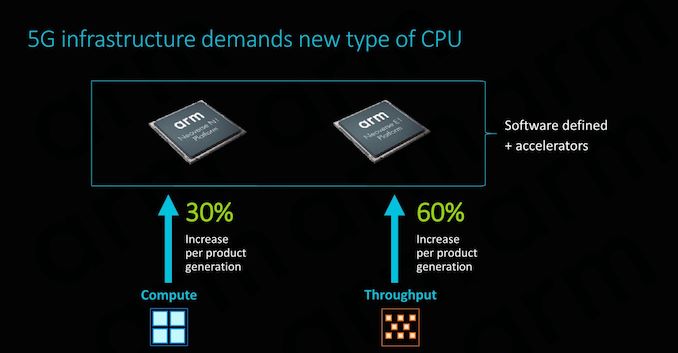
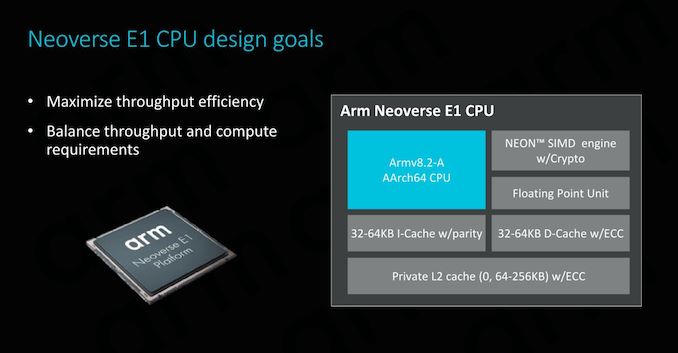
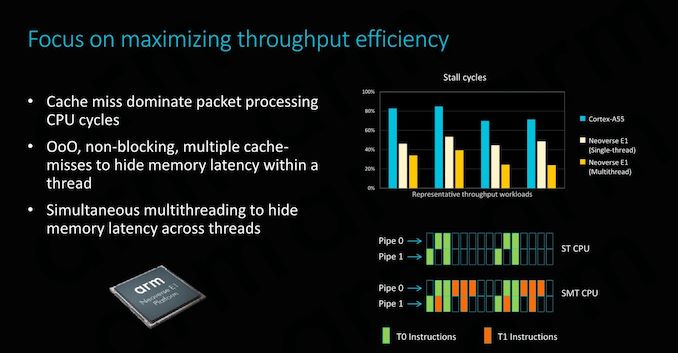
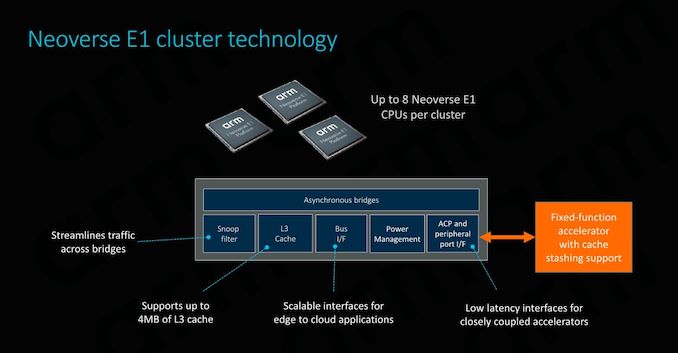
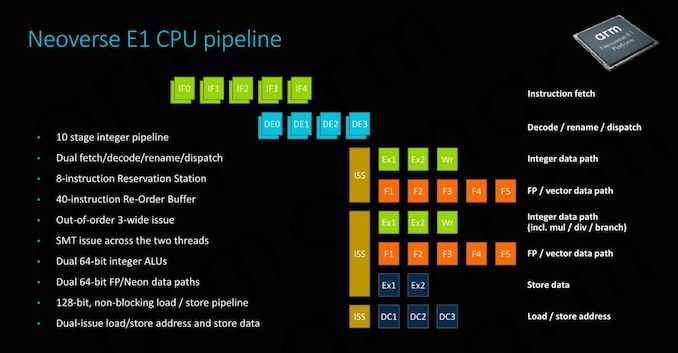
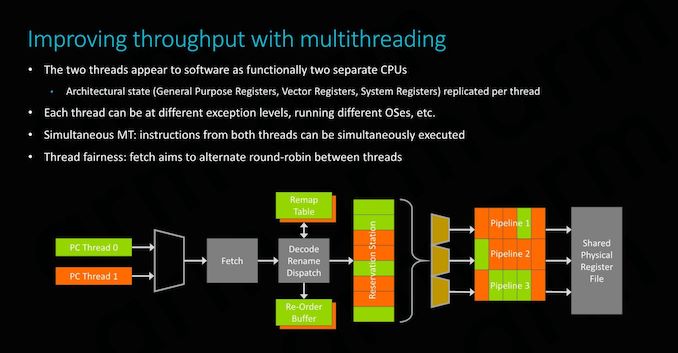
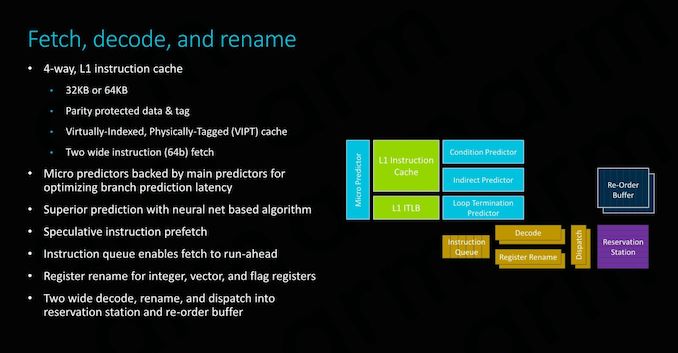
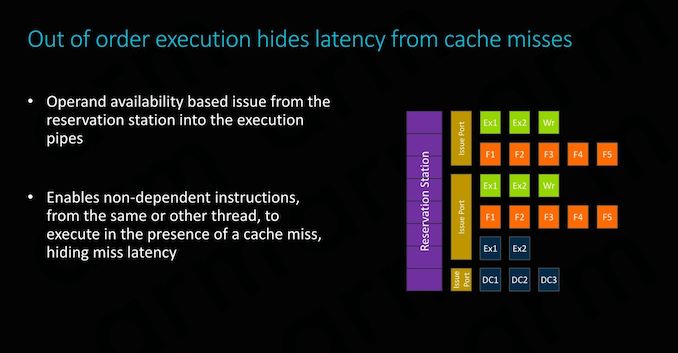

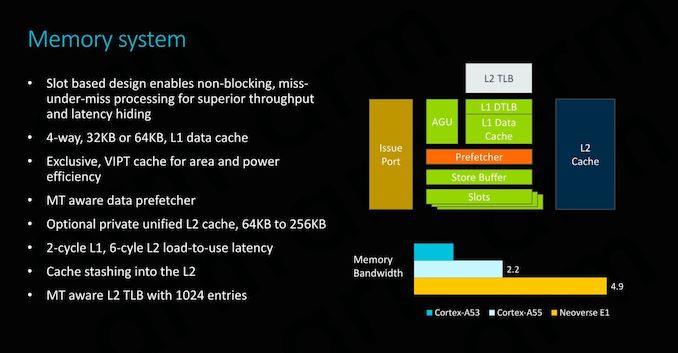








101 Comments
View All Comments
platinumjsi - Thursday, February 21, 2019 - link
Wouldnt mind seeing an Anadtech article detailing the differences between X86 and Arm and explaining the benefits and downsides of each architecture.Looking at this if ARM can do 64 cores for 105w I have to wonder why it takes AMD 250w on the same process?
Intel / AMD should be seriously worried about this.
Could we see ARM-based Laptops / Desktops? Wouldnt be any good for gaming as I cant see devs recompiling there back cataloge for ARM but for Office use these seem ideal.
SarahKerrigan - Thursday, February 21, 2019 - link
ARM laptops already exist, running Windows. Look at the Asus NovaGo or the Lenovo Yoga C630.edzieba - Thursday, February 21, 2019 - link
ARM still has to overcome the same issue that killed off every other HPC architecture (barring POWER just about hanging in there): not being x86 ( http://3s81si1s5ygj3mzby34dq6qf-wpengine.netdna-ss... ).Antony Newman - Thursday, February 21, 2019 - link
Perhaps this will all change when Apple move over to an ARM ISA? Apple would have to offer a system that is at least as capable as x86 with a significantly lower lower TCO. I think the limitation up until know was the wimpiness of the ARM offerings; the offerings were cheap but not performant.javadesigner - Friday, February 22, 2019 - link
What does the "A" in ARM stand for ? I always thought it was Apple. Does Apple make any licensing money when Samsung makes an (A)pple(R)(M) chip ?TobiWahn_Kenobi - Saturday, February 23, 2019 - link
Acorn RISC MachinesTobiWahn_Kenobi - Saturday, February 23, 2019 - link
Nowadays Advances RISC Machines.darkich - Sunday, February 24, 2019 - link
.. Isn't this basically (as expected) an expansion of the Cortex A76 architecture?techbug - Sunday, June 9, 2019 - link
intel w-3175x's rate score doesn't look right. Its single-thread score is 48.18 and 56T is 729.82. So each thread only contributes only 729.82/56=13.03, which seems to be too low.obi210 - Sunday, February 2, 2020 - link
A Neoverse E1 derivative, without SMT, could be the next gen Arm little core. Such a core with Armv9 support could provide near A73 performance. In-order A53 derivatives should not be carried over to next gen.